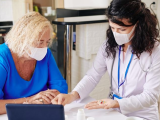(CIDRAP Business Source Osterholm Briefing) – The media may have deflected their focused attention away from the novel H1N1 influenza virus (what they've called swine flu) for the moment, but I know you're still on high alert, and with good reason.
So let's talk about what's reasonable. Perhaps the best guiding principle to keep in mind is that of proportional response. Right now, this virus is behaving like seasonal influenza. So our decisions need to be proportionate to the risk. If we invoke extreme measures when they are not warranted, we lose all credibility for when the situation truly calls for such measures. So keep that top of mind as we go into the next week.
Traveling
Much ado has been made over Vice President Joe Biden's remark on the "Today" show suggesting he wouldn’t encourage his family to travel on planes or subways, which did not jibe with official government advice and was quickly corrected by his spokesperson.
But was the vice president wrong? Was his response in proportional to the current risk? Yes, he was wrong because his response was not in proportion. Had there been tens of thousands of people dying at the moment, however, he might well have been right. Will the virus continue to behave like a seasonal strain? I'm afraid the answer is the one I've recommended we practice: We don't know yet. But the VP's faux pas reminds us of how important our credibility is and how our responses must be carefully measured.
I know that you're hearing questions about business travel right now. Should employees plan to go to big conventions this month or next, for example? Current guidance from the Centers for Disease Control and Prevention (CDC) is sound. Use it to make your best judgment.
And what if an employee is anxious about traveling and expresses that concern? First, realize that in current economic times, it took courage for the employee to raise the question. The best risk communicators, says expert Peter M. Sandman, PhD, remind people about the range of options. Share with worried employees the CDC stance, show them the recommendations posted right on the Source page. Talk about minimum protection, and if that's not enough to quell worries, discuss what even stronger precautions could look like.
After you've shared all the options and the employee just can't cope with the idea of travel, then I'd encourage you to cut your employee some slack. It's far better in the long term, and you have options, too, like sending someone else if you absolutely need this trip to happen.
Know that we'll keep you continually up to date about travel recommendations as the situation unfolds
Dealing with the fallout from school closures
Several districts this week in places like Fort Worth and San Antonio shuttered schools after the novel H1N1 influenza virus was confirmed. And that has implications for you as parents scramble to take care of children or make other arrangements.
Right or wrong? We don't know yet. Remember that we haven't watched a potential pandemic unfold like this in more than 30 years. Mistakes are going to be made, but this is a work in progress and a lesson in process. We're learning and adjusting guidance as we go, and that's the frame of mind we need right now—flexibility. Will more schools close? It's likely, but we really have to take a look at what we're accomplishing in terms of preventing transmission and severe disease by closing them. If closing schools doesn't make a difference, then we have to ask if such actions are in proportion to the risk.
Working smart
I can't let this week pass without making sure you know of a business practice I find impressive and would go so far as to say is promising. I know of a group of human resource professionals from multinational corporations who have been meeting regularly to share how they're planning. Some of them might even be considered competitors. Thus, what they've accomplished is truly remarkable, especially as the pandemic alert levels have risen so quickly.
They share without hesitation the questions they're struggling with and share solutions that have worked. They have included a representative from the state's health department who is able to keep their ideas grounded in what's real and possible. What makes the process work so well is complete confidentiality. Just a one-hour phone call was enough to help one company rethink some communication it was going to send that would have put employees and the organization in an impossible fix. Imagine the hassle and expense that they saved. The group members have even decided to ramp up their 1-hour conference calls to 3 times a week, knowing that if nothing is pressing, they can cancel, but if they need each other, the time is held in reserve.
This group was smart enough to get the initiative off the ground during the planning stage, so now their relationships are strong and mutual trust is a given. But it's not too late to do the very same thing among your peers. Perhaps your chamber of commerce could facilitate. Please consider how much effort and expense you will save if you give this a try. We all need to work smart right now to keep up our stamina.
A heads-up
As you enter the weekend, I want to make sure you know that the CIDRAP Source may be offline for a period of time on Sunday as technical experts at the university cope with a potential hot spot. If the site isn't be available during this time, know that we will still send out alerts and e-mail communication if something warrants your attention.
If the site is down, I'd encourage you to visit this CDC site for updates and Peter Sandman's site for risk communication advice.
Still to come
Our webinar this week and conversations we've had with you have raised many questions you're struggling to answer. Among them are such issues as:
- Coping without a plan. How do you protect your business at this point?
- Masks and respirators. You're coping with conflicting information and need some clarity.
- Antivirals and vaccine. How do you use antivirals now and how should they be used during a severe pandemic? Do we have enough? And what's the straight story on vaccine manufacturing capacity and plans?
- Presenteeism. How do you deal with employees whose economic insecurity has them showing up at work when they should be home?
- Recovered workers. It's unrealistic to think all employees will be tested for swine flu and given a clean bill of health from their physicians later, so how will you deal with returning workers and the worried well at work?
- Employees who cross the Mexican/US border daily. How can you realistically apply stay-at-home guidance for these workers?
We will be addressing these questions and topics in the days to come, gathering the best guidance and real-world examples we can find.
And finally, for the latest breaking news….
- The World Health Organization (WHO) reported 331 cases of swine influenza H1N1 in 11 countries as of 6 a.m. GMT today. The case numbers by country are United States, 109 (1 death) (these are yesterday's totals); Mexico, 156 (9 deaths), Canada, 34; Spain, 13; United Kingdom, 8; New Zealand, 3; Germany, 3; Israel, 2; and 1 each in Austria, the Netherlands, and Switzerland. [WHO update 7]
- The Centers for Disease Control and Prevention (CDC) reported 141 confirmed US cases in 19 states as of 11 a.m. ET today. New York leads the list with 50, followed by Texas, 28; South Carolina, 16, and California, 13. Other states have 4 or fewer cases. [CDC H1N1 flu page]
- The US government will buy 13 million treatment courses of antiviral drugs to battle the swine flu, Health and Human Services (HHS) Secretary Kathleen Sebelius announced last night. The new supplies will replace 11 million courses that HHS released to the states this week and add 2 million more, at a cost of $251 million, she said. She also said the government is sending 400,000 courses to Mexico. [HHS news release]
- Hospitals and clinics in some parts of the country, including New York, California, and Alabama, are seeing a surge of the worried well—patients who have minor symptoms but major worries about swine flu, the Associated Press (AP) reported today. For example, a pediatric hospital in San Diego is seeing up to 50% more patients than usual. [AP report]
- The first person in Mexico who became ill with what turned out to be the new flu virus got sick on Mar 17, according to an MMWR Dispatch from the Centers for Disease Control and Prevention (CDC). The first outbreak was reported to the Pan American Health Organization Apr 12. Mexico had a total of 1,918 suspected cases from Mar 1 through Apr 30, of which 286 were probable and 97 were confirmed. [MMWR Dispatch]
- Nearly 300 schools nationwide were closed yesterday because of concern about the new virus, the Washington Post reported today. Most of the schools were in Texas, where all 147 schools in the Fort Worth district were closed for 10 days after one case was confirmed and three probable cases were reported.
- Hong Kong has imposed a 7-day quarantine on about 200 guests and staff members of a hotel where a Mexican man who tested positive for swine flu stayed, according to the ChannelNewsAsia website. Authorities were also trying to trace passengers who were on the man's flight from Shanghai. A Hong Kong hotel was the launching pad for the international spread of SARS in 2003




















